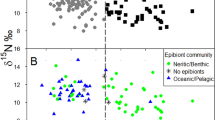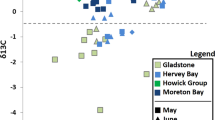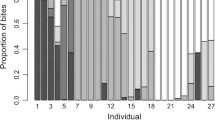Abstract
Understanding geospatial linkages is critical to the development of appropriate management and conservation strategies for migratory species. Stable isotope analysis is a powerful tool that is performed routinely across taxa to unravel migratory connectivity. Marine turtles are a highly migratory and widely distributed taxon, but are largely studied at breeding areas. Isotopic values of several slow turnover rate tissues have been used to identify often distant foraging areas. However, as more isotopic data from various tissues become available, the relationships between tissues need to be calculated to permit meta-analyses to elucidate isotopic patterns across broader spatiotemporal scales. We used several commonly collected tissues (blood, skin, fresh eggs and unhatched eggs) collected simultaneously from loggerhead turtles (Caretta caretta) to develop a common currency for stable isotope analysis studies conducted on the nesting beach. We found highly significant relationships between the tissue signatures (r 2 ranged from 0.83 to 0.96) and developed equations to convert isotopic values from one tissue to another. We examined inter- and intra-clutch isotopic variability and found that a single sampling event over the 4-month nesting season adequately defined the loggerhead female foraging area. Consequently, we propose using unhatched eggs as a common currency in stable isotope studies of nesting loggerheads. Unhatched eggs represent a noninvasive and nondestructive method that enables more extensive (both numerically and spatially) sampling. Given similar physiologies, analogous relationships might be derived in other sea turtle species.






Similar content being viewed by others
References
Arthur KE, Boyle MC, Limpus CJ (2008) Ontogenetic changes in diet and habitat use in green sea turtle (Chelonia mydas) life history. Mar Ecol Prog Ser 362:303–311. doi:10.3354/meps07440
Barton BT, Roth JD (2008) Implications of intraguild predation for sea turtle nest protection. Biol Conserv 141:2139–2145. doi:10.1016/j.biocon.2008.06.013
Bjorndal KA, Reich KJ, Bolten AB (2010) Effect of repeated tissue sampling on growth rates of juvenile loggerhead turtles Caretta caretta. Dis Aquat Organ 88:271–273. doi:10.3354/dao02175
Brace KC, Altland PD (1955) Red cell survival in the turtle. Am Physiol Soc 183:91–94
Broderick AC, Coyne MS, Fuller WJ, Glen F, Godley BJ (2007) Fidelity and over-wintering of sea turtles. Proc R Soc B 274:1533–1538. doi:10.1098/rspb.2007.0211
Caut S, Fossette S, Guirlet E, Angulo E, Das K, Girondot M, Georges JY (2008) Isotope analysis reveals foraging area dichotomy for Atlantic leatherback turtles. PLoS ONE 3:e1845. doi:10.1371/journal.pone.0001845
Ceriani SA, Roth JD, Evans DR, Weishampel JF, Ehrhart LM (2012) Inferring foraging areas of nesting loggerhead turtles using satellite telemetry and stable isotopes. PLoS ONE 7:e45335. doi:10.1371/journal.pone.0045335
Chabot AA, Hobson KA, Van Wilgenburg SL, McQuat GJ, Lougheed SC (2012) Advances in linking wintering migrant birds to their breeding-ground origins using combined analyses of genetic and stable isotope markers. PLoS ONE 7:e43627. doi:10.1371/journal.pone.0043627
Cherel Y (2008) Isotopic niches of emperor and Adélie penguins in Adélie Land, Antarctica. Mar Biol 154:813–821. doi:10.1007/s00227-008-0974-3
Cherel Y, Hobson KA, Bailleul F, Groscolas R (2005) Nutrition, physiology, and stable isotopes: new information from fasting and molting penguins. Ecology 86:2881–2888. doi:10.1890/05-0562
Cherel Y, Jaquement S, Maglio A, Jaeger A (2014) Differences in δ13C and δ15N values between feathers and blood of seabird chicks: implications for non-invasive isotopic investigations. Mar Biol 161:229–237. doi:10.1007/s00227-013-2314-5
Clegg SM, Kelly JF, Kimura M, Smith TB (2003) Combining genetic markers and stable isotopes to reveal population connectivity and migration patterns in a neotropical migrant, Wilson’s Warbler (Wilsonia pusilla). Mol Ecol 12:819–830
Cooper JA (1978) The history and breeding biology of the Canada Geese of Marshy Point, Manitoba. Wildl Monogr 61:3–87
Ehrhart L, Bagley D, Redfoot W (2003) Loggerhead turtles in the Atlantic Ocean: geographic distribution, abundance, and population status. In: Bolten AB, Witherington BE (eds) Loggerhead sea turtles. Smithsonian Institution Press, Washington, pp 157–174
Florida Fish and Wildlife Conservation Commission (2007) Marine turtles conservation guidelines. http://myfwc.com/wildlifehabitats/managed/sea-turtles/conservation-guidelines/
Foley AM, Schroeder BA, Hardy R, MacPherson SL, Nicholas M, Coyne MS (2013) Postnesting migratory behavior of loggerhead sea turtles Caretta caretta from three Florida rookeries. Endang Species Res 21:129–142. doi:10.3354/esr00512
Frankel NS, Vander Zanden HB, Reich KJ, Williams KL, Bjorndal KA (2012) Mother-offspring stable isotope discrimination in loggerhead sea turtles Caretta caretta. Endang Species Res 17:133–138. doi:10.3354/esr00412
Girard C, Tucker AD, Calmettes B (2009) Post-nesting migrations of loggerhead sea turtles in the Gulf of Mexico: dispersal in highly dynamic conditions. Mar Biol 156:1827–1839. doi:10.1007/s00227-009-1216-z
Gross MR (1991) Salmon breeding behavior and life history evolution in changing environments. Ecology 72:1180–1186. doi:10.2307/1941091
Hamann M, Limpus CJ, Owens DW (2003) Reproductive cycles of males and females. In: Lutz PL, Musick JA, Wyneken J (eds) The biology of sea turtles II. CRC Press LLC, Boca Raton, pp 135–162
Hamann M, Godfrey MH, Seminoff JA, Arthur K, Barata PCR, Bjorndal KA, Bolten AB, Broderick AC, Campbell LM, Carreras C, Casale P, Chaloupka M, Chan SKF, Coyne MS, Crowder LB, Diez CE, Dutton PH, Epperly SP, FitzSimmons NN, Formia A, Girondot M, Hays GC, Cheng IS, Kaska Y, Lewison R, Mortimer JA, Nichols WJ, Reina RD, Shanker K, Spotila JR, Tomás J, Wallace BP, Work TM, Zbinden J, Godley BJ (2010) Global research priorities for sea turtles: informing management and conservation in the 21st century. Endang Species Res 11:245–269. doi:10.3354/esr00279
Hatase H, Takai N, Matsuzawa Y, Sakamoto W, Omuta K, Goto K, Arai N, Fujiwara T (2002) Size-related differences in feeding habitat use of adult female loggerhead turtles Caretta caretta around Japan determined by stable isotope analyses and satellite telemetry. Mar Ecol Prog Ser 233:273–281
Hatase H, Sato K, Yamaguchi M, Takahashi K, Tsukamoto K (2006) Individual variation in feeding habitat use by adult female green sea turtles (Chelonia mydas): are they obligately neritic herbivores? Oecologia 149:52–64. doi:10.1007/s00442-006-0431-2
Hawkes LA, Witt MJ, Broderick AC, Coker JW, Coyne MS, Dodd M, Frick MG, Godfrey MH, Griffin DB, Murphy SR, Murphy TM, Williams KL, Godley BJ (2011) Home on the range: spatial ecology of loggerhead turtles in Atlantic waters of the USA. Divers Distrib 17:624–640. doi:10.1111/j.1472-4642.2011.00768.x
Hobson KA (1999) Tracing origins and migration of wildlife using stable isotopes: a review. Oecologia 120:314–326. doi:10.2307/4222394
Hobson KA, Norris RD (2008) Animal migration: a context for using new techniques and approaches. In: Hobson KA, Wassenaar LI (eds) Tracking animal migration with stable isotopes. Terrestrial ecology series. Academic Press, London, pp 1–19
Hobson KA, Wassenaar LI (1997) Linking breeding and wintering grounds of neotropical migrant songbirds using stable hydrogen isotopic analysis of feathers. Oecologia 109:142–148. doi:10.2307/4221502
McClellan CM, Braun-McNeill J, Avens L, Wallace BP, Read AJ (2010) Stable isotopes confirm a foraging dichotomy in juvenile loggerhead sea turtles. J Exp Mar Biol Ecol 387:44–51
McCune B, Grace JB, Urban DL (2002) Analysis of ecological communities. MjM Software Design, Gleneden Beach
Miller JD, Limpus CJ, Godfrey MH (2003) Nest site selection, oviposition, eggs, development, hatching, and emergence of loggerhead turtles. In: Bolten AB, Witherington BE (eds) Loggerhead sea turtles. Smithsonian Institution Press, Washington, pp 125–143
Norris DR, Marra PP, Kyser TK, Sherry TW, Ratcliffe LM (2004) Tropical winter habitat limits reproductive success on the temperate breeding grounds in a migratory bird. Proc R Soc B 271:59–64
Owens DW, Ruiz GJ (1980) New methods of obtaining blood and cerebrospinal fluid from marine turtles. Herpetologica 36:17–20
Páez-Rosas D, Aurioles-Gamboa D, Alava JJ, Palacios DM (2012) Stable isotopes indicate differing foraging strategies in two sympatric otariids of the Galapagos Islands. J Exp Mar Biol Ecol 424–425:44–52. doi:10.1016/j.jembe.2012.05.001
Pajuelo M, Bjorndal KA, Reich KJ, Vander Zanden HB, Hawkes LA, Bolten AB (2012) Assignment of nesting loggerhead turtles to their foraging areas in the Northwest Atlantic using stable isotopes. Ecosphere 3, art89. doi 10.1890/es12-00220.1
Plot V, Jenkins T, Robin JP, Fossette S, Georges JY (2013) Leatherback turtles are capital breeders: morphometric and physiological evidence from longitudinal monitoring. Physiol Biochem Zool 86(4):385–397
R Development Core Team (2011) R: a language and environment for statistical computing. R Foundation for Statistical Computing, Vienna, Austria
Reich KJ, Bjorndal KA, Martinez Del Rio C (2008) Effects of growth and tissue type on the kinetics of 13C and 15N incorporation in a rapidly growing ectotherm. Oecologia 155:651–663. doi:10.1007/s00442-007-0949-y
Reich KJ, Bjorndal KA, Frick MG, Witherington BE, Johnson C, Bolten AB (2010) Polymodal foraging in adult female loggerheads (Caretta caretta). Mar Biol 157:113–121. doi:10.1007/s00227-009-1300-4
Roscales JL, Gómez-Díaz E, Neves V, González-Solís J (2011) Trophic versus geographic structure in stable isotope signatures of pelagic seabirds breeding in the northeast Atlantic. Mar Ecol Prog Ser 434:1–13. doi:10.3354/meps09211
Rosenblatt AE, Heithaus MR (2013) Slow isotope turnover rates and low discrimination values in the American alligator: implications for interpretation of ectotherm stable isotope data. Physiol Biochem Zool 86:137–148. doi:10.1086/668295
Schroeder BA, Foley AM, Bagley DA (2003) Nesting patterns, reproductive migrations, and adult foraging areas of loggerhead turtles. In: Bolten AB, Witherington BE (eds) Loggerhead sea turtles. Smithsonian Institution Press, Washington, pp 114–124
Seminoff JA, Bjorndal KA, Bolten AB (2007) Stable carbon and nitrogen isotope discrimination and turnover in pond sliders Trachemys scripta: insights for trophic study of freshwater turtles. Copeia 2007:534–542. doi:10.2307/25140663
Seminoff JA, Benson SR, Arthur KE, Eguchi T, Dutton PH, Tapilatu RF, Popp BN (2012) Stable isotope tracking of endangered sea turtles: validation with satellite telemetry and δ15N analysis of amino acids. PLoS ONE 7:e37403. doi:10.1371/journal.pone.0037403
Stearns S (1992) The evolution of life histories. Oxford University Press, London xii, p 249
Tucker AD (2010) Nest site fidelity and clutch frequency of loggerhead turtles are better elucidated by satellite telemetry than by nocturnal tagging efforts: implications for stock estimation. J Exp Mar Biol Ecol 383:48–55. doi:10.1016/j.jembe.2009.11.009
Tucker AD, MacDonald BD, Seminoff JA (2014) Foraging site fidelity and stable isotope values of loggerhead turtles tracked in the Gulf of Mexico and Northwest Caribbean. Mar Ecol Prog Ser 502:267–279
Vander Zanden HB, Arthur KE, Bolten AB, Popp BN, Lagueux CJ, Harrison E, Campbell CL, Bjorndal KA (2013) Trophic ecology of a green turtle breeding population. Mar Ecol Prog Ser 476:237–249. doi:10.3354/meps10185
Wallace BP, Avens L, Braun-McNeill J, McClellan CM (2009) The diet composition of immature loggerheads: insights on trophic niche, growth rates, and fisheries interactions. J Exp Mar Biol Ecol 373:50–57. doi:10.1016/j.jembe.2009.03.006
Wallace BP, DiMatteo AD, Bolten AB, Chaloupka MY, Hutchinson BJ, Abreu-Grobois FA, Mortimer JA, Seminoff JA, Amorocho D, Bjorndal KA, Bourjea J, Bowen BW, Briseno Duenas R, Casale P, Choudhury BC, Costa A, Dutton PH, Fallabrino A, Finkbeiner EM, Girard A, Girondot M, Hamann M, Hurley BJ, Lopez-Mendilaharsu M, Marcovaldi MA, Musick JA, Nel R, Pilcher NJ, Troeng S, Witherington B, Mast RB (2011) Global conservation priorities for marine turtles. PLoS ONE 6:e24510. doi:10.1371/journal.pone.0024510
Wilson SG, Polovina JJ, Stewart BS, Meekan MG (2006) Movements of whale sharks (Rhincodon typus) tagged at Ningaloo Reef, Western Australia. Mar Biol 148:1157–1166. doi:10.1007/s00227-005-0153-8
Wilson S, Hobson KA, Collister DM, Wilson AG (2008) Breeding destinations and spring migration patterns of Swainson’s thrush (Catharus Ustulatus) at a Costa Rican stopover site. Auk 125:95–104. doi:10.1525/auk.2008.125.1.95
Witteveen BH, Worthy GAJ, Roth JD (2009) Tracing migratory movements of breeding North Pacific humpback whales using stable isotope analysis. Mar Ecol Prog Ser 393:173–183. doi:10.3354/meps08231
Zbinden JA, Bearhop S, Bradshaw P, Gill B, Margaritoulis D, Newton J, Godley BJ (2011) Migratory dichotomy and associated phenotypic variation in marine turtles revealed by satellite tracking and stable isotope analysis. Mar Ecol Prog Ser 421:291–302. doi:10.3354/meps08871
Acknowledgments
We thank B. Sharma, R. Woods, A. Hays, A. Sterner, C. Sanchez, C. Long, K. Martin, C. Johnson, C. Sasso and D. Evans for their help with fieldwork. We thank G. Worthy and the PEBL lab for providing laboratory access and advice and C. Amato, R. Chabot and F. Gusmao for help in the laboratory. We thank the Archie Carr National Wildlife Refuge Managers and in particular K. Kneifl for supporting our research. We thank Y. Cherel and two anonymous reviewers for comments that improved the manuscript. The animal use protocol for this research was reviewed and approved by the University of Central Florida Institutional Animal Care and Use Committee (IACUC protocol #09-22W). Procedures were approved under the Florida Fish and Wildlife Conservation Commission (Marine Turtle Permit #025). This work was supported by several grants awarded from the Sea Turtle Grants Program (09-055R, 10-020R, 10-023R, 11-021R). The Sea Turtle Grants Program is funded from proceeds from the sale of the Florida Sea Turtle License Plate. Learn more at www.helpingseaturtles.org.
Author information
Authors and Affiliations
Corresponding author
Additional information
Communicated by Y. Cherel.
Rights and permissions
About this article
Cite this article
Ceriani, S.A., Roth, J.D., Ehrhart, L.M. et al. Developing a common currency for stable isotope analyses of nesting marine turtles. Mar Biol 161, 2257–2268 (2014). https://doi.org/10.1007/s00227-014-2503-x
Received:
Accepted:
Published:
Issue Date:
DOI: https://doi.org/10.1007/s00227-014-2503-x




